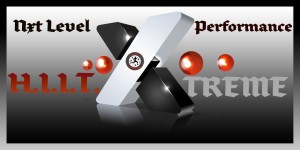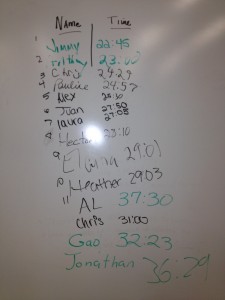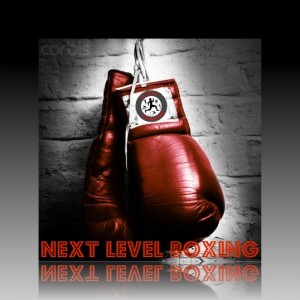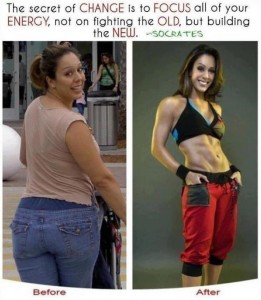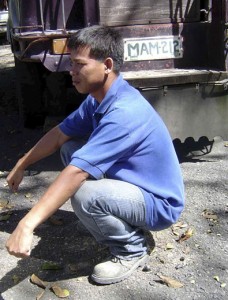ROD 060712
ROD
Thursday, 07Jun12
This class is built for speed, agility and strength. This class is not for convenience, it’s for the challenge. This class is for those who want to PUSH themselves and be PUSHED. Every participant will be expected to perform the suggested lb’s for each movement and post their time or rounds completed when applicable to comments.
For time of…
Perform 25 reps of each then run 200m, 20 reps of each then run 200m, 15 reps of each then run 200m , 10 reps of each then run 200m, 5 reps of each then run 200m.
- Barbell Thrusters
- Box Jump
- Push-ups
- Ball Slams
Results
_________________________________________________________
Are You Ready for ?
Our Super High Intensity Boxing Circuit class is a 1 hour ass kicking class that will leave you in a fatigued state of mind & body.
Your cardiorespiratory and muscular endurance will benefit from our motivational, challenging but fun circuit training which is always set to energetic music.
We will push you to see what you’ve got!!!!
____________________________________________________________
Need Inspiration to succeed in our Trim Down?
_________________________________________________________________________
Your Ass Is a Non- Weight Bearing Surface a.k.a That’s Why Your Back Hurts!
A week or two ago I posted a video of Kelly Starrett from Mobility WOD, explaining the difference between a weight bearing surface and a non-weight bearing surface. What he was talking about wasthe difference on the skin on your palms, feet and your butt. Check out the video again, and do it yourself. Take a look at your palms and notice how thick the skin is. Take a look at your feet. It is the same, right? And now think about the skin on your butt. I bet you know it is a lot smoother without even taking a look at it!
What does that mean? Why is does it happen like that?
As Kelly Starrett, explains the butt is a non-weight bearing surface. That means your butt was never meant to be your “sit bones”. You were never meant to spend countless hours sitting on your butt and putting stress on your back. Give it a thought. Do you remember your great grandmother? Remember how she was really active in her late 80s, she didn’t complain of constant lower back pain, she wasn’t taking painkillers because of the unbearable pain. Then why nowadays every person has low back problems? Why are we unable to endure intense physical activities, because so many back injuries are interfering with our proper and pain free movements?
Maybe the video answers that question! Because the butt is a non-weight bearing surface.
I’ve been researching some pictures and articles about the life of people in third world countries. What you will notice is the way they rest, the way they eat, the way they squat. You are hardly ever gonna see somebody of them looking for a chair in order to sit on the table and have lunch. You are hardly ever gonna see them kneeling or squatting on their toes, when they pick up something from the floor.
What they do, is they actually squat with perfect form. See the picture below! They could sit in this position for hours without feeling uncomfortable. And how does that matter? By doing so, their glutes are doing what they were designed to do. Their back doesn’t take all the stress to keep your body in line, while you are resting on your ass. The way they squat, assures that every muscle in the body is doing the work it was designed to do. None of the muscles is overworking trying to compensate for the inactivity of other muscles.
And what happens nowadays. We think we created a lot of commodities- chairs, tables and so forth, that are supposed to make our life easier. And in reality they are making it torturous! Why? As Craig Weller explained in this great article, called “The third world squat”:
“The classic North American squatting down to grab something from a low shelf or play with his VCR is going to balance on his toes and shoot his knees forward. He’s going to try and make the movement feel as much as possible like his natural environment, which is sitting in an office chair.
The hips and ankles are immobilized and because the force is being relegated mainly to the quads, the effect of the posterior chain is minimized. The musculature of the lower back will be overactive in order to support the weight of the upper body without much assistance from the glutes. The thoracic spine will generally be flexed forward into a kyphotic posture.”
Ouch, that hurts even reading it! That pretty much explains why it is so hard for so many people to squat with good form. That pretty much explains why so many people have such severe back injuries.
That reminds me of people, who often tell me how they don’t squat because that hurts their back and their knees. Truth is NOT SQUATTING IS HURTING YOUR BACK AND YOUR KNEES!
I know that it is hard to spend a lot of time in a squatting position as it would be weird to do so in the office or in public, but we should give it a thought and spend as much time as possible standing, walking, just moving!
Here I found another great article (NLP’ers read this), where the author of the book “8 Steps for a Pain- Free Back”, shared her opinion on why adults find it so hard to squat with proper form, and on the other hand children squat perfectly.
Here is what she said:
1. At birth, many of our joints (including the ankles, knees and hips) are not ossified. Instead of bone, we have cartilage in those areas.
2. Each of the above joints has a timetable for when the cartilage ossifies. The hip joint, for example, is made of three parts – the ischeum, ileum and pubis – each pair of which ossifies at a different age (first pair at age 2; last pair at age 16).
3. Once your joints have ossified, they are relatively immutable. Bone does change shape depending on the stresses on it, but it does not change drastically and in particular, the above ossifications are irreversible.
4. If you grow up squatting (on pit toilets, eating on the floor, etc) then the joints ossify differently than if you grew up sitting on chairs and using commodes for toilets. In particular, if you grew up squatting, your joints will ossify in a way that allow you to continue to squat in adulthood. If you did not squat through the years that your ankles, knees, and hips were ossifying, you will probably not be able to do a healthy full squat in adulthood.
5. People who force squats without having he joint architecture to do them tend to round their backs (compressing their spinal discs), pronate their ankles, and stress their knees.
6. Recommendation: don’t try to force a squat. In most situations you can do the job equally well with a modified squat (on foot flat on the floor, the other on the ball of the foot). The times squatting does help are childbirth and evacuating your bowels. In these situations I recommend using some extra support under your heels – this makes squatting easy on the ankles and back. For other situations like certain squatting Yoga poses, I recommend not going all the way into the pose.”
I really wanted to raise this topic and make you think further about it, because the solution to the growing back injuries, might be really simple- just minimize the time you spend sitting and squat more often!
Have you ever thought about this? Did you know the difference between a weight bearing surface and non-weight bearing surface?
P.S. If you liked this post, please share it with your friends! I’d greatly appreciate it!

